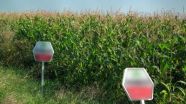(Press-News.org) Leaves of the plant that yields carob — the substitute for chocolate that some consider healthier than chocolate — are a rich source of antibacterial substances ideal for fighting the microbe responsible for listeriosis, a serious form of food poisoning, according to a report in ACS' Journal of Agricultural and Food Chemistry.
Nadhem Aissani and colleagues explain that the increase in antibiotic-resistant bacteria has fostered a search for new natural substances to preserve food and control disease-causing microbes. They cite a need for new substances to combat Listeria monocytogenes, bacteria that caused food poisoning outbreaks in a dozen states with three deaths so far this year. Carob has attracted attention as a potential antibacterial substance, but until now, scientists had not tested it against Listeria. Carob may be best-known as a substitute for chocolate that does not contain caffeine or theobromine, which makes chocolate toxic to dogs.
Their report describes tests in which extracts of carob leaves proved effective in inhibiting the growth of Listeria bacteria growing in laboratory cultures. Further, it offers a possible explanation for the antibacterial action. The results were promising enough for the scientists to plan further tests of carob extracts on Listeria growing in meat and fish samples.
###
The American Chemical Society is a nonprofit organization chartered by the U.S. Congress. With more than 164,000 members, ACS is the world's largest scientific society and a global leader in providing access to chemistry-related research through its multiple databases, peer-reviewed journals and scientific conferences. Its main offices are in Washington, D.C., and Columbus, Ohio.
To automatically receive news releases from the American Chemical Society, contact newsroom@acs.org.
Leaves of carob tree, source of chocolate substitute, fight food-poisoning bacteria
2012-10-18
ELSE PRESS RELEASES FROM THIS DATE:
Cleaner fracking
2012-10-18
The technology that opened a wealth of new natural gas resources in the U.S. is producing millions of gallons of dirty water — enough from one typical gas well to cover a football field to a depth of 9-15 feet. Cleaning up that byproduct of "fracking" is the topic of the cover story of the current issue of Chemical & Engineering News. C&EN is the weekly newsmagazine of the American Chemical Society, the world's largest scientific society.
Melody M. Bomgardner, C&EN senior business editor, explains that hydraulic fracturing, or fracking, uses a mixture of water and chemicals ...
Mathematics and the ocean: Movement, mixing and climate modeling
2012-10-18
Philadelphia, PA – October 17, 2012—Studying the dynamics of the ocean system can greatly improve our understanding of key processes of ocean circulations, which have implications for future climate. Can applying mathematics to the research help? Dr. Emily Shuckburgh of the British Antarctic Survey, speaking at the 2012 SIAM Annual Meeting, thinks the answer is an emphatic "yes."
Dr. Shuckburgh described mathematical ideas from dynamical systems used by her group, along with numerical modeling and experimental observations, to analyze circulation in the Southern Ocean. ...
Why are our salt marshes falling apart?
2012-10-18
WOODS HOLE, Mass.—Salt marshes have been disintegrating and dying over the past two decades along the U.S. Eastern seaboard and other highly developed coastlines, without anyone fully understanding why. This week in the journal Nature, MBL Ecosystems Center scientist Linda Deegan and colleagues report that nutrients—such as nitrogen and phosphorus from septic and sewer systems and lawn fertilizers—can cause salt-marsh loss.
"Salt marshes are a critical interface between the land and sea," Deegan says. "They provide habitat for fish, birds, and shellfish; protect coastal ...
Breech births cause more problems for moms and babies when water breaks early
2012-10-18
MAYWOOD, Ill. – Breech births increase the risk of complications for the mother and baby when the amniotic sac ruptures early. These findings were presented today by a researcher from Loyola University Health System at the 79th Annual Meeting of the Central Association of Obstetricians and Gynecologists in Chicago.
Preterm, premature rupture of the amniotic sac contributes to one-third of all preterm births. A rupture is considered premature when it occurs before the onset of labor prior to 37 weeks' gestation. When the amniotic sac breaks prematurely, it can lead to ...
New fruit fly model of epilepsy reveals mechanisms behind fever-induced seizures
2012-10-18
Irvine, Calif., Oct. 17, 2012 – UC Irvine and Brown University researchers have created a new fruit fly model of inherited epilepsy that's providing insights into the mechanisms underlying temperature-dependent seizures while establishing a platform from which to develop therapies for these disorders.
In the Oct. 10 issue of The Journal of Neuroscience, Diane O'Dowd of UCI, Robert Reenan of Brown and colleagues report their method for placing a gene mutation that causes human fever-induced seizures into drosophila fruit flies. As a result, the mutant flies experience ...
USDA scientists collaborate with global researchers to advance the mapping of the barley genome
2012-10-18
WASHINGTON, October 17, 2012--In a major advance that will unlock the benefits of the mapping of the barley genome--one of the world's most important cereal crops--work conducted and supported by the U.S. Department of Agriculture (USDA) in collaboration with researchers around the world has resulted in the most advanced sequencing of the barley genome to date, as reported today in the journal Nature. The advance will give researchers the tools to produce higher yields, improve pest and disease resistance, and enhance nutritional value of barley. Past genomic research supported ...
Living Voters Guide adds fact-checking by Seattle librarians for 2012 election
2012-10-18
When facing a difficult choice, many of us turn to that old standby: the pro-con list. A University of Washington project takes election pro-con lists to the next level, moving them online and allowing voters to work together to draft points – brief arguments for or against – and refine their positions.
Now in its third year, the Living Voters Guide, presented in partnership with Seattle's CityClub, just won a regional award and has been updated for the 2012 election. This year the guide has expanded to include a California edition, and the Washington guide will include ...
A European-wide network for systematic GMO impact assessment
2012-10-18
In Europe there are many concerns about adverse environmental effects of GM crops, and the opinions on the outcomes of environmental risk assessments (ERA) differ largely. GM crop safety testing and introduction studies among the regulatory system are insufficiently developed. Therefore the proposed framework aims at improving the regulatory system.
Specific elements of the network are a) methodologies for both indicator and field site selection for GM crop ERA and PMEM, b) an EU-wide typology of agro-environments, c) a pan-European field testing network using GM crops, ...
Keck observations bring weather of Uranus into sharp focus
2012-10-18
MADISON – In 1986, when Voyager swept past Uranus, the probe's portraits of the planet were "notoriously bland," disappointing scientists, yielding few new details of the planet and its atmosphere, and giving it a reputation as a bore of the solar system.
Now, however, thanks to a new technique applied at the Keck Observatory, Uranus is coming into sharp focus through high-resolution infrared images, revealing in incredible detail the bizarre weather of the seventh planet from the sun.
The images were released in Reno, Nev. today (Oct. 17, 2012) at a meeting of the ...
U of M scientist contributes to mapping of barley genome
2012-10-18
MINNEAPOLIS / ST. PAUL (10/17/2012) —An international team of researchers, including a University of Minnesota scientist, has developed an integrated physical, genetic and functional sequence assembly of the barley genome, one of the world's most important and genetically complex cereal crops. Results are published in today's issue of Nature.
The advance will give researchers the tools to produce higher yields, improve pest and disease resistance, and enhance the nutritional value of barley.
Importantly, it also will "accelerate breeding improvements to help barley ...


